How can you take your feline friend for a walk on the wild side? This best cat harness for walking review covers the main styles and offers advice on using them.
Cats can adapt to walking with a harness and leash, although it may take a lot of patience and training. Walking your cat on a harness is valuable when you live a nomadic life. We have a whole section on cat travel if you are planning a trip.
Cats need their senses stimulated, and measures to avoid boredom should be used. Besides cat play, walking on a harness is a great boredom buster. To walk your cat on a leash, you need to have an excellent harness. We review the best cat harness on the market and give you some great tips for training your kitty to go walkies.
In our opinion, there is no cat harness we have found that is 100% escape-proof. However, we do believe that some are better than others. We have used a number of different styles of cat harnesses with varying success.
Not every cat can be trained to walk on a leash. If (after unsuccessful training) you now believe your cat is never going to take to walking on a leash, don’t despair. There are other options, such as cat strollers and/or (our favorite) cat backpacks – check out our cat back review.
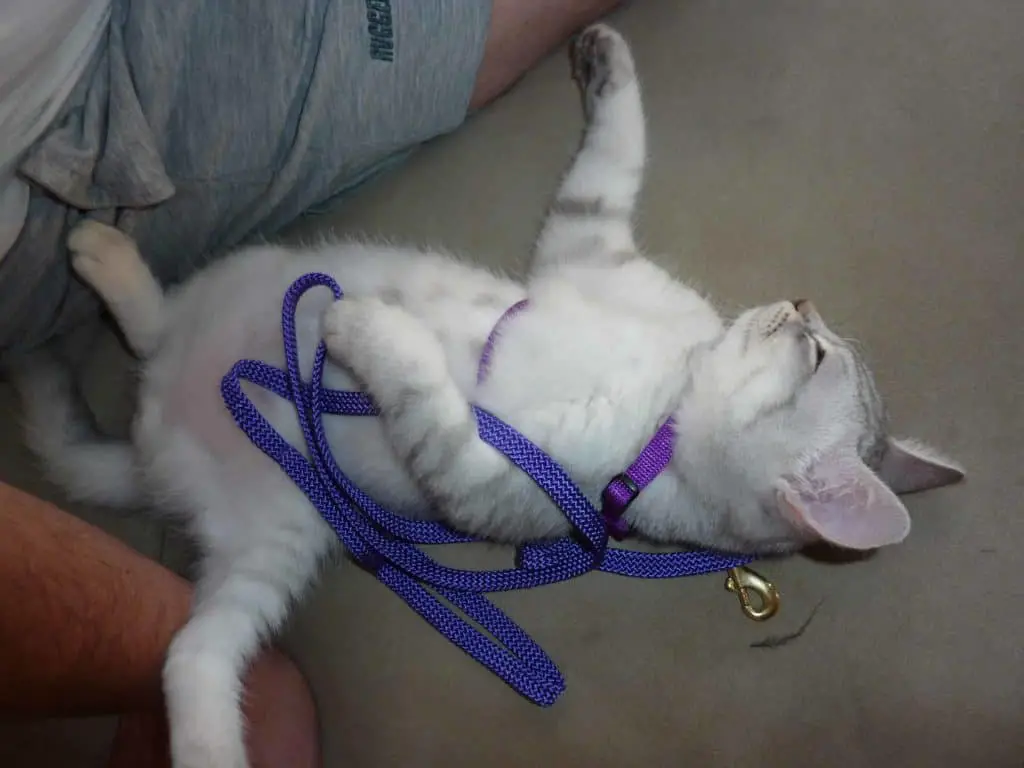
Play with your cat at home to introduce the cat harness as part of fun play. Check out our cat play ideas.
Cats are agile and robust. When they are scared, they will protect themselves from perceived danger and/or escape. Harness training is a valuable tool to minimize the chance of escape. It is not a silver bullet and can lead to problems. However, it can be an essential part of your cat protection strategy with training and careful use. See our articles on cat safety for more information.
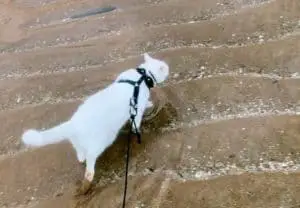
WARNING
Never leave your cat unattended when they are on the lead.
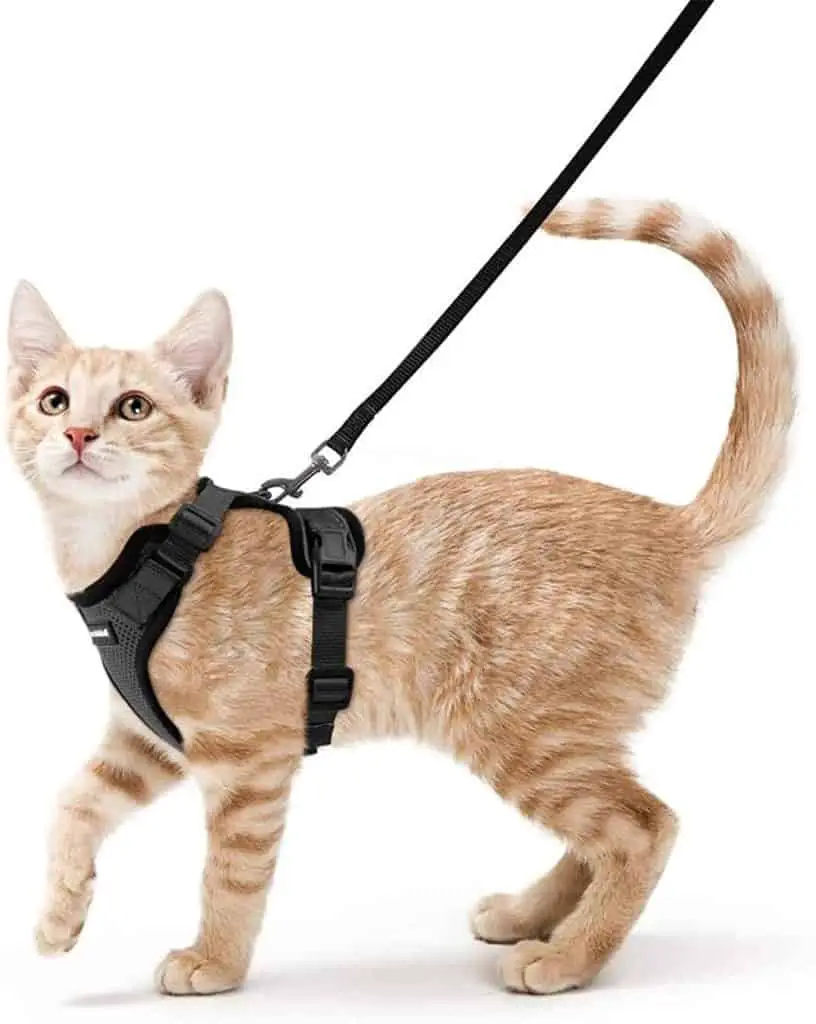
Best Cat Harness for walking
Rabbitgoo cat harness and Leash
Buy on Amazon
As an Amazon Associate, Walkabout Cat earns from qualifying purchases.
Perhaps one reason we are fascinated by cats is because such a small animal can contain so much independence, dignity, and freedom of spirit. Unlike the dog, the cat’s personality is never bet on a humans. He demands acceptance on his own terms.
Lloyd Alexander

15 steps to train your cat to walk with a harness
- Before you start harness training, find out what treats motivate your cat. You will need them to reward good behavior. Cats need to be harness trained indoors first. It is crucial.
- Leave the harness out in a common area so it can be sniffed and inspected.
- To familiarize, attempt to use the harness and leash as play toys. Offer a treat as a reward for play with the harness.
- Place it with your sleeping cat to help transfer its scent onto the harness.
- Strap the harness onto your cat. This is best done just before a meal. Offer a treat as a reward. Do not attempt to adjust the harness. It is okay if it’s loose.
- It is usual for your cat to refuse to walk or stagger while the leash is on. Persevere and leave it on for a few minutes unless the cat is stressing too much. Reward just after taking the harness off.
- If your kitty is too stressed, take the harness off and start from the beginning. Don’t forget to reward good behavior. See our article on cat anxiety.
- Once your cat is accepting of the harness, put it on and adjust it to fit properly. Don’t forget the reward. You should be able to fit one finger under the harness, but no more. Keep in mind your cat can back itself out of the harness, so it needs to be reasonably tight. Leave the harness on, then provide a treat.
- Leave the harness on for longer periods of time until your cat is used to it. Reward.
- Attach the leash and let your cat drag it around indoors. Do not leave the cat unattended. Reward.
- Once accustomed to the leash, you can start trying to entice your cat to let you lead. Cats are not like dogs; they must be led with gentle pressure. Let your cat move to the end of the lead, then add slight pressure until the cat turns the way you want it to go. It must always look like it is the cat’s decision. Did you think it would be any other way?
- Reward good behavior with a treat, ignore bad behavior.
- Once your kitty is used to the harness, it is time to move outside. Start in a safe area, such as a fenced backyard. Keep walks short until you feel your cat is ready for longer walks.
- Never leave your cat unattended when outdoors. Never tie your cat up, either indoors or out.
- Once your cat is used to the harness, stay consistent with only letting her outside with the harness on.
Patience is more than a virtue with cats
We did mention that not all cats can be harness trained. Even those who can be taught will not be easy. It isn’t. It takes patience. Our best cat harness review will help to select a great harness for your kitty. Please give the harness a good try before writing kitty off as not trainable. This is a chance to really practice patience.
In our best cat harness for walking review we look at the top two cat harness types
H-Harness
- Head does not need to be pushed through the harness.
- Least amount of contact area on your cat.
- Typically have two points to fasten.
- More adjustable than the vest harness.
Vest Harness
- Looks like a vest.
- Typically fasten on the back.
- More contact with your cat’s body.
- Most require you to put over the cats head when putting it on.
- Usually made from mesh or breathable material.
- Often more escape-proof than an H-Harness.
Considerations before buying a harness
- Some cats do not like the sound of Velcro.
- The weather may impact your decisions; the harness may make kitty too hot or too cold.
- Some larger cats (like ours) may fit in a dog harness.
- Cat harnesses with mesh have more breathability.
- Longer hair cats can get hair caught in Velcro and/or clasps.
- Measure first – harness should be tight enough that you only fit one finger beneath it.
- Most cats have multiple harnesses suitable for various situations.
Best Cat Harness For Walking – Product Review
Best Cat Harness – Overall -Rabbitgoo Cat Harness And Leash (Vest Harness)
The Rabbitgoo is made of breathable fabric. This means kitty is much less likely to become overheated. The reflective strips and a metal leash ring are also great safety features.
| PROS | CONS |
|---|---|
| + 4 adjusting straps ensuring a good fit + Breathable + Sturdy + Comes with a leash +Easy to get on, do not have to put a leg through +Comes in several colors | – Neck strap has to be pulled over the head – May be too large for smaller sized cats – Not escape-proof |
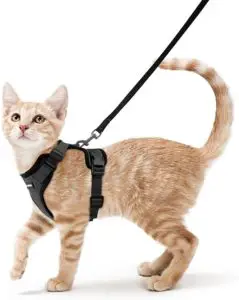
Best Cat Harness – Runner Up – PetSafe “Come With Me” Kitty Harness And Bungee Leash (H-Harness)
This is a very popular harness among cat owners. It has an adjustable sternum slide and dual adjustment points on the girth straps, which allow for a nice snug fit.
| PROS | CONS |
|---|---|
| + Chest strap tightens if the cat tries to pull away + Bungee leash is elastic preventing harsh pulling + Easy to adjust + Light and easy to fit on the cat + Sturdy + Comes in several colors | – Size runs small – Straps twist easily – May catch fur in long-haired cats – Not escape-proof |
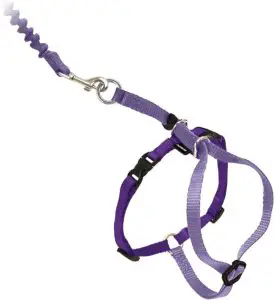
Best Cat Harness – Look & Style – Kitty Holster Cat Harness (Vest Harness)
This harness comes in four sizes and is adjustable via Velcro, ensuring a snug fit. It is described as “stiff,” which could make it more difficult for the cat to pull out of. For the discerning kitty, it comes in different colors and patterns.
| PROS | CONS |
|---|---|
| + Thin, durable fabric + Cotton lining + Lightweight + Not difficult to fasten snaps + Ships Internationally + Has some great colors and patterns + Easy to put on + Easily adjustable with the Velcro | – The stiffness could make the harness less comfortable – The Velcro could get stuck on fur or carpet – Velcro sound may scare a cat – Does not include a leash – Not escape-proof |
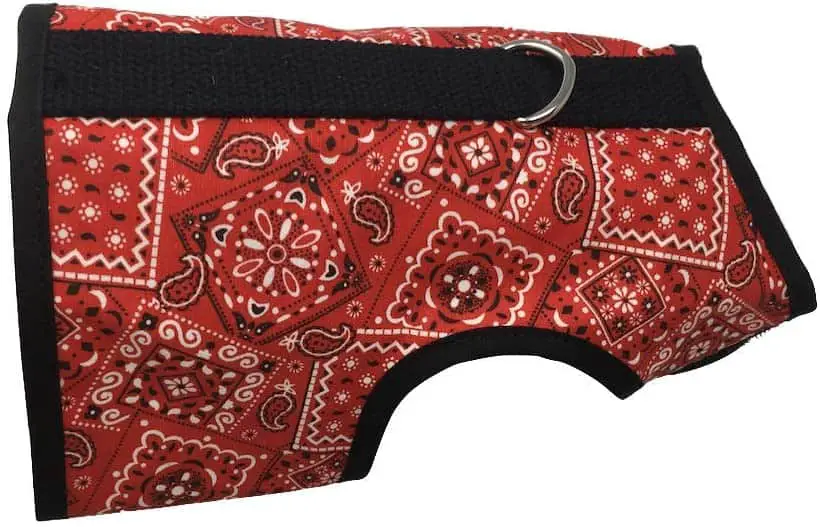
Best Cat Harness – Easiest To Put On – Escape Proof Cat Harness And Leash, Adjustable Cat Walking Jacket, Padded Cat Vest
Although named Escape Proof, we believe there is no such thing, and that will be our opinion until proven otherwise. That said, this has adjustable enclosures ensuring a nice snug fit.
| PROS | CONS |
|---|---|
| + Adjustable at chest and neck + Velcro closure for ease of use + Padded + Extra layer of mesh for ventilation + Easy to adjust + Various colors + Comes with a leash | – Runs on the small side – The Velcro could get stuck on fur or carpet – Some cats will still be able to escape the harness |
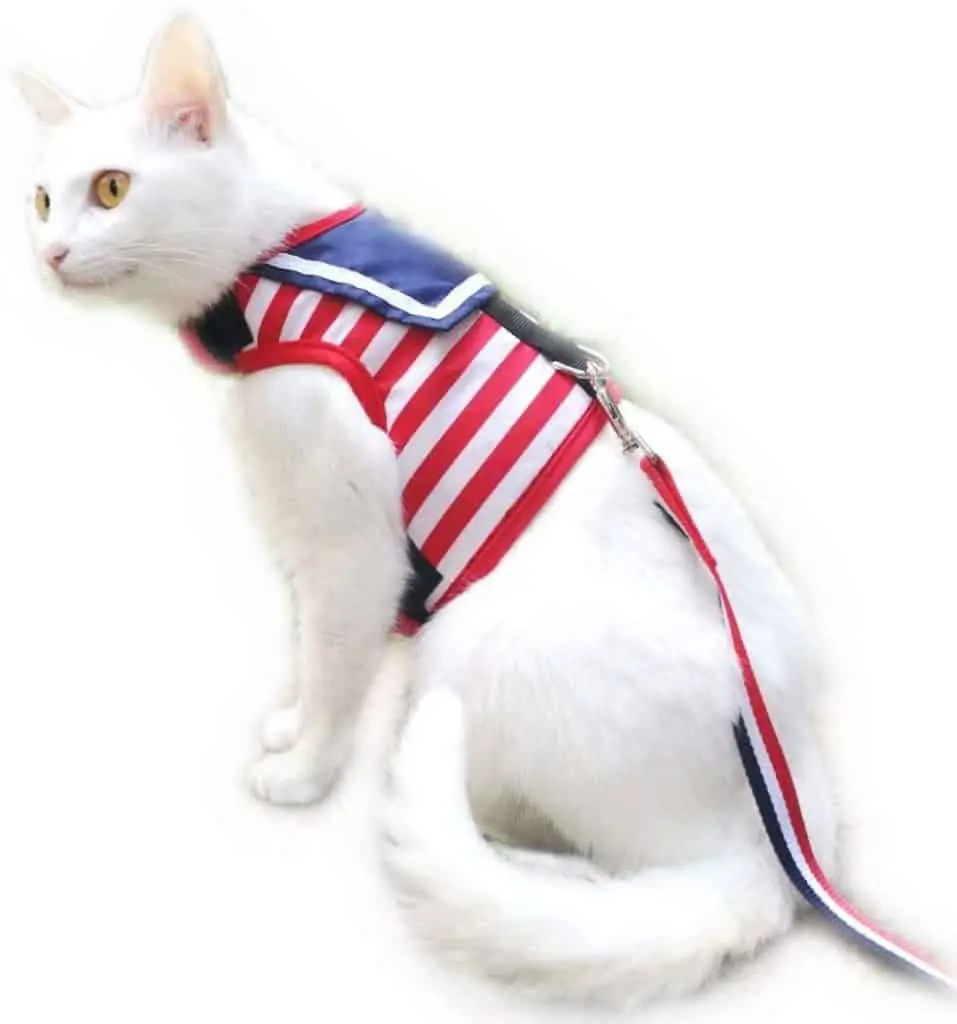
Avoiding Danger
- Stay away from high traffic, noisy or crowded areas.
- Never attach a leash to your cat’s collar.
- Do not trust dogs to behave, even on leash.
- Dogs can be hazardous to a cat who has no place to run for safety.
- Have a backup plan. We always take the cat’s backpack when we are walking with leash. That way, if danger appears, the cat becomes anxious or is finished with walking, we can pop her in the backpack.
- On a short walk around your campsite or vehicle, leave a door open so kitty can run to safety.
- Keep the experience a positive one.
Thanks you for reading our cat harness review – Questions People Ask
Why is my cat freezing up, falling over or staggering?
When a cat first feels a harness, it triggers a survival or kitten response, causing the cat to freeze, stagger, or fall over. This is the same response a cat would use if grabbed by a predator or if its mother picked it up. It’s normal. Just start playing with kitty to see if you can get them moving. You need to be patient and start slow. Some cats lay down and refuse to move. This will change as they become more comfortable and get used to the feeling of a harness. Do not ever drag your cat on the leash. It takes time.
What do I do if my cat is trying to get out of the harness?
Do everything possible not to let your cat back up. Always stay behind your cat. If you let kitty get behind you, that is when they can back out of a harness. Instead, when you want to lead your cat in a different direction, gently put slight pressure on the leash in the direction you wish kitty to go. Sometimes that is enough. Other times the cat will keep trying to pull before finally changing direction. It is a bit like sailing.
What if my cat will not be led?
Let’s face it, most cats never really get used to being led; they prefer to browse. They do become comfortable with gentle persuasion. If your cat does get used to the harness but not with being led on a leash, keep the harness on her whenever you take her out and keep trying. The harness is the most difficult part.
What if my cat never takes to the harness?
There are other options, such as enclosed outdoor cat enclosures or cages. There are also cat strollers and backpacks, or kitty might prefer to be an inside cat all the time. We have a great cat backpack review.
How tight should the harness be?
You should only be able to fit one finger under the harness, both at the neck and at the belly. This may seem snug, but it is your best bet for an escape-proof experience.
Can I just put a leash on my cat’s collar?
No. It is dangerous. Unlike dogs, cats have a soft throat that can become damaged either through too much pressure from pulling or if the cats become hooked up on something. Both scenarios can cause permanent internal damage.
My cat can back out of the harness. Why?
As we have mentioned, we do not believe there is an escape-proof harness. That said, a harness that is too big is easier to back out of. Harnesses should be quite snug with only enough space for one finger under the harness. If kitty can get a foot through, resulting in being able to back out, then the harness needs to be tightened.
